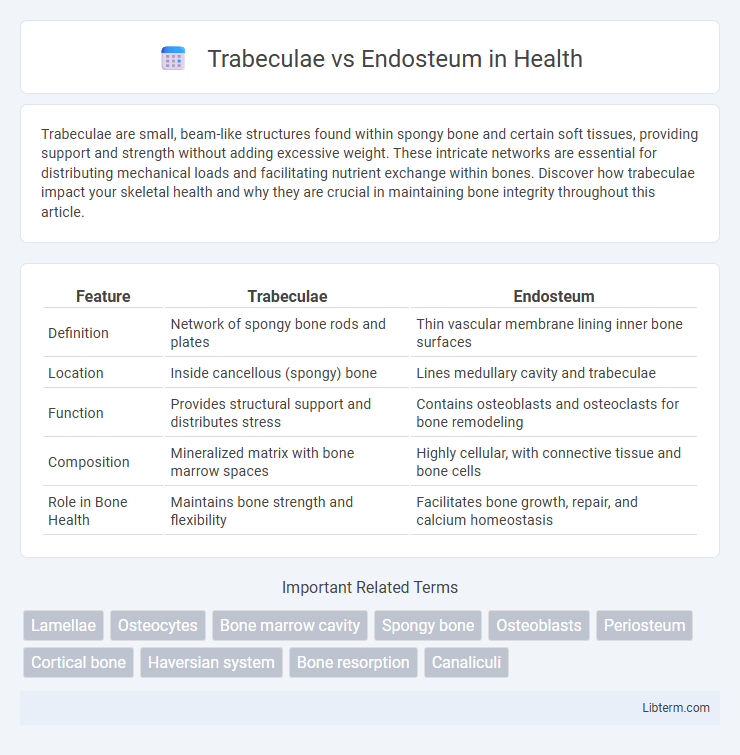Trabeculae are small, beam-like structures found within spongy bone and certain soft tissues, providing support and strength without adding excessive weight. These intricate networks are essential for distributing mechanical loads and facilitating nutrient exchange within bones. Discover how trabeculae impact your skeletal health and why they are crucial in maintaining bone integrity throughout this article.
Table of Comparison
| Feature | Trabeculae | Endosteum |
|---|---|---|
| Definition | Network of spongy bone rods and plates | Thin vascular membrane lining inner bone surfaces |
| Location | Inside cancellous (spongy) bone | Lines medullary cavity and trabeculae |
| Function | Provides structural support and distributes stress | Contains osteoblasts and osteoclasts for bone remodeling |
| Composition | Mineralized matrix with bone marrow spaces | Highly cellular, with connective tissue and bone cells |
| Role in Bone Health | Maintains bone strength and flexibility | Facilitates bone growth, repair, and calcium homeostasis |
Introduction to Trabeculae and Endosteum
Trabeculae are the lattice-like structures within spongy bone that provide structural support and facilitate the distribution of mechanical forces. The endosteum is a thin vascular membrane lining the inner surfaces of bones, including the trabeculae, playing a critical role in bone growth, repair, and remodeling. Both trabeculae and endosteum contribute to bone health by maintaining the balance between bone formation and resorption.
Definition of Trabeculae
Trabeculae are the small, lattice-shaped structures of spongy bone that provide structural support and house bone marrow. These porous, interconnecting rods form the internal framework of cancellous bone, optimizing strength while reducing weight. The endosteum is the thin vascular membrane lining the inner surface of bone cavities, including the trabecular spaces, playing a key role in bone growth, remodeling, and repair.
Definition of Endosteum
Endosteum is a thin vascular membrane lining the inner surface of the bony tissue, including the medullary cavity and trabeculae of spongy bone, playing a crucial role in bone growth, repair, and remodeling. Trabeculae are the lattice-like network of rod-shaped structures forming the spongy bone interior, providing structural support and housing bone marrow. The endosteum contains osteoblasts and osteoclasts, facilitating the dynamic balance between bone formation and resorption.
Anatomical Location: Trabeculae vs Endosteum
Trabeculae are the lattice-like structures found within the spongy bone, primarily located in the epiphyses of long bones and inside flat bones, providing structural support and housing bone marrow. The endosteum is a thin vascular membrane lining the internal surfaces of the bone, including the medullary cavity, trabeculae, and Haversian canals, playing a critical role in bone growth, remodeling, and repair. While trabeculae constitute the bony framework, the endosteum serves as the cellular interface involved in bone metabolism and hematopoiesis.
Structural Composition Differences
Trabeculae consist of a lattice-like network of calcified bone matrix forming spongy bone tissue, characterized by interconnecting rods and plates that provide structural support and house bone marrow. The endosteum is a thin, vascularized membrane lining the inner surface of the medullary cavity and trabecular bone, composed mainly of osteoblasts, osteoclasts, and connective tissue cells responsible for bone growth, repair, and remodeling. Unlike the rigid, mineralized trabeculae, the endosteum is a cellular, non-mineralized layer essential for regulating bone homeostasis and turnover.
Functional Roles in Bone Physiology
Trabeculae provide structural support and facilitate the distribution of mechanical loads within spongy bone by forming a porous lattice that maximizes strength while minimizing weight. The endosteum, a thin vascular membrane lining the inner bone surfaces, plays a crucial role in bone remodeling by housing osteoblasts and osteoclasts responsible for bone formation and resorption. Together, trabeculae and the endosteum maintain bone homeostasis, adapting bone structure dynamically in response to mechanical stress and metabolic demands.
Cellular Components of Trabeculae and Endosteum
Trabeculae primarily consist of a lattice of spongy bone containing osteocytes embedded within the mineralized matrix and are lined by osteoblasts responsible for bone formation and osteoclasts involved in bone resorption. The endosteum is a thin vascular membrane lining the inner surface of bones, rich in osteoprogenitor cells, osteoblasts, and osteoclasts, playing a crucial role in bone remodeling and repair. These cellular components facilitate dynamic bone turnover, with trabecular osteocytes maintaining matrix integrity while endosteal cells regulate bone growth and resorption.
Involvement in Bone Remodeling
Trabeculae are the lattice-like structures within spongy bone providing a surface for osteoblast and osteoclast activity during bone remodeling. The endosteum, a thin vascular membrane lining the inner surfaces of trabeculae and medullary cavity, hosts osteoprogenitor cells essential for remodeling and bone repair. Together, trabeculae and endosteum coordinate bone resorption and formation to maintain skeletal strength and calcium homeostasis.
Clinical Relevance and Disorders
Trabeculae are the lattice-like structures in spongy bone crucial for providing structural support and housing bone marrow, while the endosteum is a thin vascular membrane lining the inner surface of bones, playing a key role in bone growth and remodeling. Disorders such as osteoporosis result from increased trabecular bone loss, weakening bone architecture and increasing fracture risk. Pathologies involving the endosteum, like endosteal inflammation or fibrosis, can impair bone healing and contribute to conditions such as osteomyelitis or delayed fracture repair.
Summary: Key Differences Between Trabeculae and Endosteum
Trabeculae are the lattice-like structures of spongy bone that provide support and house bone marrow, while the endosteum is a thin vascular membrane lining the inner surfaces of the bone, including the trabeculae. Trabeculae contribute to the structural integrity and distribution of mechanical stress within cancellous bone, whereas the endosteum plays a critical role in bone growth, repair, and remodeling by housing osteoblasts and osteoclasts. Both trabeculae and endosteum are essential for bone health, but trabeculae serve as the physical scaffold, and the endosteum functions as the biological interface for bone metabolism.
Trabeculae Infographic

 libterm.com
libterm.com